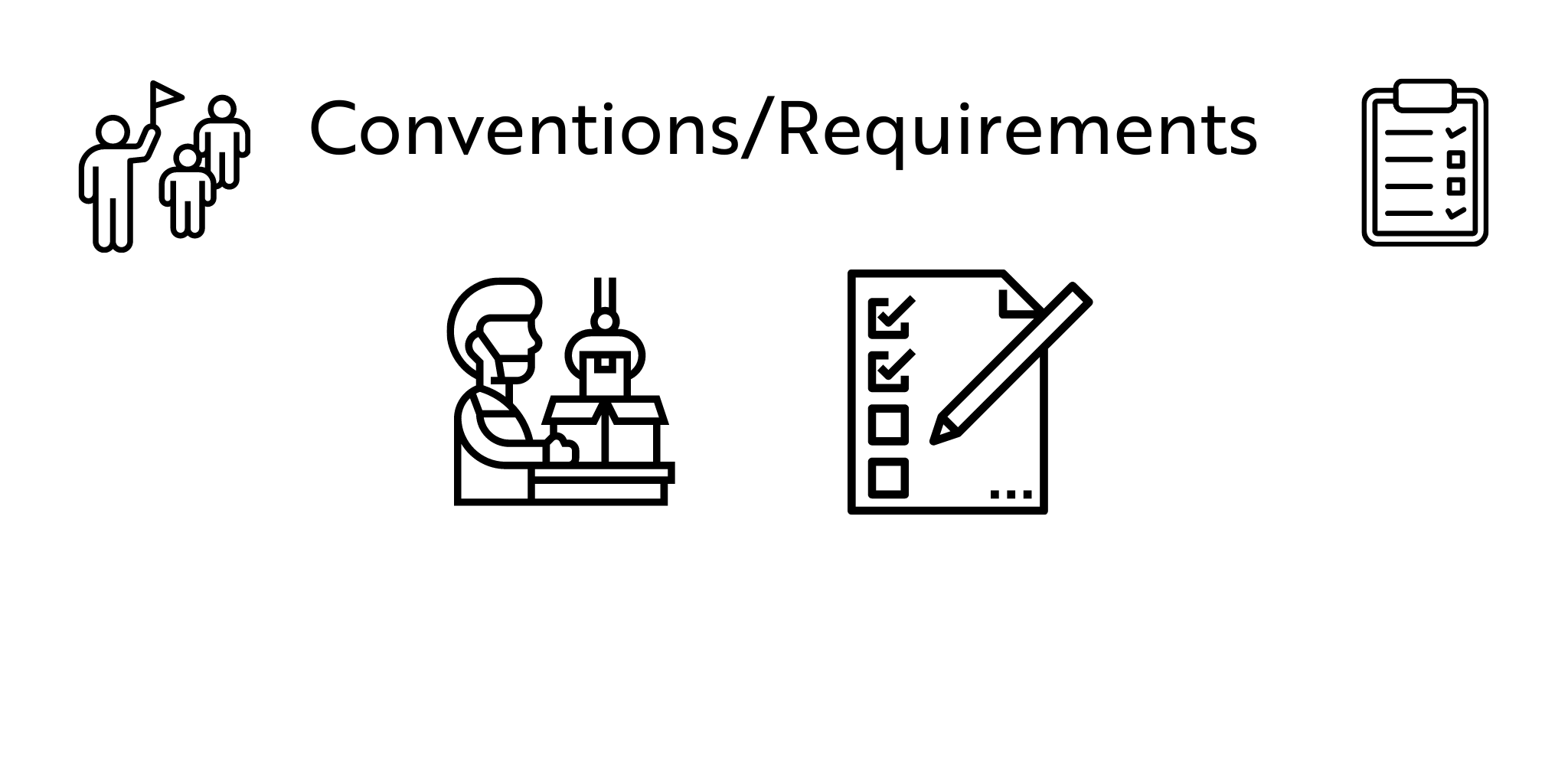What Are the Conventions & Requirements for your Brand?
Conventions and Requirements are the frameworks in which all similar offerings must adhere. If an offering does not comply with generally accepted conventions (e.g. testimonials from medical doctors) then prospects will be skeptical.

People expect certain things when they see a movie, talk to a doctor, and when they buy an offering. These expectations reduce their anxiety and prime them to accept whatever claims are being put forth. The best example of this is those drug commercials on TV.
By law, each and every drug commercial has to have a disclaimer on the adverse side effects of the drug. This usually comes towards the end and is a litany of rare but serious side effects that are almost as worst as the disease the drug is trying to cure.
If you’re watching a drug commercial and don’t see that, you’ll be suspicious and discount it outright. Those disclosures are required and we expect them. The same goes for toothpaste commercials.
Would you buy a toothpaste that 4 out of 5 dentists did not recommend? Maybe but the power of the recommended by is a convention that is hard-pressed to pass up for toothpaste. Do you see what we mean?
Be The Same But Different
Conventions and Requirements are the frameworks in which all similar offerings must adhere. If an offering does not comply with generally accepted conventions (e.g. testimonials from medical doctors) then prospects will be skeptical. The same goes for requirements (e.g. drug side effects) since we, as consumers, are programmed to pick up on these standards and norms of what is expected. Stray from that expectation and doubt will creep in.
Meeting Your Audiences Expectations
Humans are excellent pattern matters. We do this to avoid cognitive overload because the world is full of stimuli. CEOs of fast-growing companies take this idea of cognitive overload so seriously that they wear the exact same outfit every day to reduce decision fatigue. This notion to make it simple and easy to make a decision on our offering is at the heart of Conventions and Requirements. We want to have our prospect’s pattern matching minds see the familiar in our offering and not have to figure out what it is. We want all of their cognitive energy focused on “wow, this is a great offer for <insert offering here>” instead of “exactly what is this again?”
We’re going to break down the Conventions and Requirements for the Structure + Service of your offering. Eventually, we’ll build some reference sheets for the most common mix of Core Values, Structures, and Service. For now, we’re gonna slog through these first ones below to get the ball rolling. We’ll also add a section to figure out your unique set of Conventions + Requirements since there are a lot of permutations.
If you have any suggestions on other conventions and requirements, let us know and we’ll add them to the list. This will be a work in progress so check back frequently for updates. Here we go!
Product Conventions + Requirements
A physical or digital product that a customer buys one time. Upgrades for digital products provided as part of a support warranty or replacement in the case of a physical product.
Conventions
- Free Shipping
- One year warranty on craftsmanship issues. Usually called Parts + Labor
- Instant Download for Digital Products
- 30-day Money-Back Guarantee
- Extended warranty available for purchase
- Support for one-year included
- Upgrades for one-year for Digital Products
- Referral program
Requirements
- Detailed Description + Specifications + Pictures
- Usage of the product side effects (e.g. drugs)
- Regulatory compliance certification if needed (FCC, EU, etc).
- Countries you ship to if you have a physical product.
Services Conventions + Requirements
Services perform work on something to fix or improve it. They don’t have a physical deliverable except for a receipt or maybe a report after a service is performed like getting a haircut, washing your car, getting your car fixed, or getting a massage.
Services also include credit cards, which make buying things easier. Although they can also have a subscription component. Can you see how this can be complex quickly?
Software as a Service (SaaS) we consider a subscription and will handle those next.
Conventions
- Ability to pre-buy packs of service
- Loyalty programs or cashback for using.
Requirements
- Licensed and bonded
- Warranty on parts and labor performed on physical objects (like a car)
Subscription Conventions + Requirements
Subscriptions like Software as a Service (SaaS) are tools that make your digital life better. Services like email, accounting, and digital marketing automation all fall into this category. Courses and communities that you pay to be part of also fall here as do streaming services like Spotify and Netflix.
We consider Box subscription services that ship physical products monthly a hybrid and will handle those separately.
Conventions
- Free or discounted trial for a limited time (7 or 30 days)
- Discounts for annual vs monthly billing
- Tiers of service you can upgrade/downgrade too
- Download your data
- Single Sign-On
- Two-factor authentication
- Mobile friendly
- Referral program
Requirements
- Email login
- Password Recovery
- Pay with Credit Card
Donations Conventions + Requirements
Donations are typically made to a non-profit organization and are tax-deductible. Others, like for a GoFundMe site, are for specific things like medical costs, etc.
For donations, it’s the cause that’s the “product or service” and typically the donor does not get anything in return other than a good feeling about helping.
Conventions
- 501(c)3 registered
- Specific campaigns to donate too
- Rewards for donating like a t-shirt or coffee mug
Requirements
- Donate online via credit card
- Acknowledgement of a donation.
- Receipt for tax purposes if a 501(c) 3.
Product + Subscription Conventions + Requirements
Product + subscription have a physical product that needs a subscription to actually work. Think of your cell phone. Without the monthly service, it would be a fancy (and expensive) eBook reader.
Conventions
- Different levels of subscription service
- Some sort of monthly or yearly fee
Requirements
- The subscription enables the key features of the product.
Core Value Specific Conventions + Requirements
As you can imagine, there are specific conventions + requirements for each of the core values. We’ll be creating specific references for each one of them and as they are completed, we’ll link to them below. For now, we’re just going to list them out.
- Performance
- Status
- Merriment
- Humanity
- Equality
- Worldview
- Morality
- Love
- Belonging
- Cowboy
As we have discussed, brands can have a primary core value and a secondary one. In that case, the conventions + requirements for both will be a mix of the two depending on which one is primary and secondary. We’ll now look at some common combinations.
Combinations of Core Value Conventions + Requirements
There are common combinations of core values that come up time and time again. As we look at more and more brands, we’ll probably find additional combinations. For now, we’ll add them as we find them and also create references for each.
- Performance + Status
- Performance + Love
- Worldview + Performance
Figuring out Conventions + Requirements
As you can see, there can be a lot of permutations for Conventions + Requirements. It’s almost impossible to consider every combination of product, service, or subscription. That’s why we have come up with a method to figure out Conventions + Requirements for a specific product or brand.
Question #1: What do your competitors do?
Take a look at your top competitors (3-5) and write down what they do related to their offerings. Pay particular attention to the fine print as well. Even though you may want to be different than competitors, conventions and requirements are not the place for that. Customers will expect certain things from your brand that they are custom too.
Question #2: What are the regulatory requirements?
Regulatory requirements vary from industry to industry and country to country. Make sure you understand what has to be in place in order to sell your products or services. This is particularly important when it comes to industries that deal with healthcare and financial services when it comes to data protection and privacy.
Question #3: What do brands do in adjacent markets?
Sometimes it’s not clear what conventions and requirements should be followed if you’re creating a new market or have few competitors. In that case, it’s best to look at adjacent markets that might offer something similar or are recognized for being leaders in their industry.
For example, Tesla upgrades the software in their cars remotely. Traditionally, this type of upgrade was done at a service appointment. For smart cars, this is starting to become the convention.
Question #4: What do master brands with your Core Values do?
Take a look at the master brands that have the same core values as your brand. Our core value reference sheets will have a list of some. Look at what they do and how they position themselves. It’s a safe bet to assume that what master brands are the conventions and requirements for that particular core value.
While our Core Value Reference sheets have several examples of master brands and conventions + requirements, you can also do your own research and analysis by doing a Brand Story Guide for those brands you look up to or want to emulate.
Convention Criteria
Criteria for a convention is when the majority of your competitors and master brands do the same thing. It’s a convention because it’s either not required to be successful or it’s optional. For example, free shipping is a convention for most brands that have physical products or if you buy over a certain amount of goods.
Requirements Criteria
Requirements are when something is required by law or everyone else in your industry or with your same core values does it. It’s a requirement because the people that interact with those brands will expect it from your brand. We want to meet expectations so that the prospect or customer or advocate does not have to waste precious time or brain power on trying to figure out your brand. For example, a SaaS offering has to have a unique login to know who you are and how to bill you.
Next Up: A Macro View of Your Story
The last part of the Brand Story Guide is the macro view of your brand’s story. We start with the macro view because we want to see the lay of the land so to speak. It’s also easier to see the full thru line of your brand’s story as opposed to being down in the weeds at the micro-level within the funnel.
Are you ready to get your story straight by having a Brand Thru-line?

